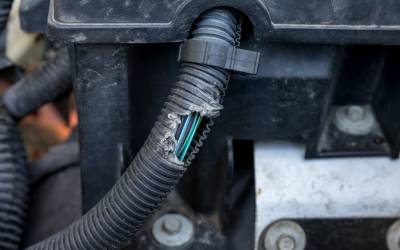In the spring or summer, rodents may not pay your vehicle any mind. But when the weather dips close to freezing here in Michigan, your car suddenly turns into a very appealing source of shelter and other valuable resources. The last thing you want is for a rat, mouse or squirrel to call shotgun on your ride to work or errands. You need to know what to look for, and that includes the signs of damage that rodents can leave once they’re inside your vehicle. At Griffin Pest Solutions, we specialize in rodent control for homes and businesses in Michigan, and if you have pests in your car, it won’t be long until that’s exactly what you’ll need. So stay one step ahead of these critters if you watch for the three signs of rodents in your car, and what you can do to keep them out.
Rodent Damage in Your Car
If rats, mice, or other rodents get into your car, they tend to damage the inside of your vehicle in three key areas. It may look like the following:
Chewing
Rodents have constantly growing incisors, and because of that, they chew to sharpen and grind down their teeth. When they’re inside your vehicle, they’ll chew on anything they have access to. This may look like plastic paneling, or it could be something as important as the wires and power steering lines that make up your car’s inner structure. It’s very possible that they can bite clean through something important without you realizing it. That’s why this is easily the most dangerous form of damage a rat or mouse can do to your vehicle.
Nesting
If a rat or mouse wants to hide inside your car, it’s usually to build a nest out of the way of bad weather. Once they establish that they’ve found a supposedly safe place, they’ll set about gathering material to make into a nest. This could be harvested from your carpet insulation, the interior upholstery of your seats, or any other soft materials that may be left in your car. They can nest in any location in your car’s chassis, but the most common places are usually the warmest. This means the heater blower motors, engine compartments, trunks, and under the center console.
Leaving Waste
It’s no surprise that rats and mice are fond of defecating wherever they go, and if they get in your vehicle, it won’t be long before they defecate there too. Not only will that make being in your car far more unpleasant – it can also be dangerous for yourself and those you drive around. Because rodents spread diseases through their droppings, like hantavirus and salmonellosis, and being in contact with their leavings can easily make someone ill. That’s why it’s so important not to provide them with access to your car.
Keeping Rodents Out
When it comes to keeping rats, mice and other rodents out of your car, the standard isn’t too different from keeping them out of your home. You close off access by keeping the windows and sunroof rolled up, and you remove potential food sources by keeping your car’s interior clear of clutter. Storing your car in the garage reduces the risk, but we understand that’s not an option for everybody. If you have to keep your car in the driveway or on the street, there are other precautions you can take. A solution of peppermint oil, clove, or cayenne can be sprayed in and around your car a few times a week to deter mice and rats. You can also sprinkle cedar shavings or sawdust to create a barrier around your car that rodents won’t want to cross.
These are all measures you can take on your own when dealing with a rodent presence in your vehicle. But if you find evidence of rodents in your home, we do not suggest trying to clear out an infestation on your own. Instead, trust the team of rodent exterminators at Griffin Pest Solutions to treat your home and get rid of the rodents or any other pests you may have. To get started, contact us today!

